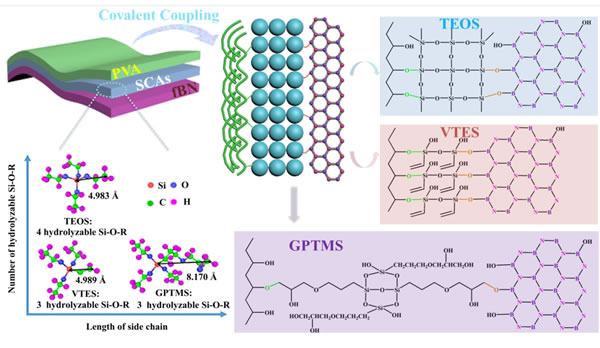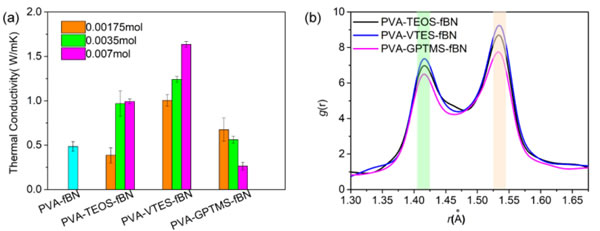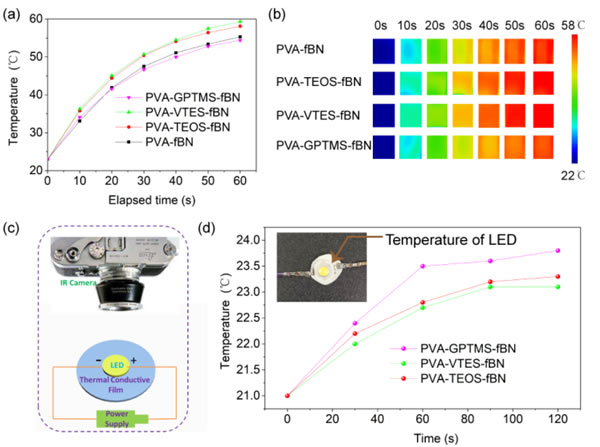Recently, the Polymer and Composite Materials Research Department of the Institute of Solid Physics, Hefei Academy of Material Sciences, Chinese Academy of Sciences has cooperated with the University of Aarhus, Denmark, and the University of Science and Technology of Norway to choose a suitable silane coupling agent structure to achieve molecular level control. Thermal conductivity of composite materials, and further explore its control mechanism. The related research results are published in Composites Part A: Applied Science and Manufacturing under the title of Covalent coupling regulated thermal conductivity of poly(vinyl alcohol)/boron nitride composite film based on silane molecular structure.
With the development of electronic products in the direction of miniaturization and multi-function, the degree of integration has rapidly increased and the power density has increased significantly. The resulting heat dissipation difficulties affect the working stability and life of the device. At present, polymer materials occupy a dominant position in electronic packaging materials. Generally, polymer materials are poor conductors of heat, and the development of high thermal conductivity polymer thermal management materials has become an urgent problem to be solved. Adding high thermal conductivity components to polymer materials is one of the common methods to improve the thermal conductivity of composite materials. However, the heat carrier phonons are easily scattered by the thermally conductive components and the polymer interface, which limits the heat transfer efficiency. The polymer/thermal conduction component interface becomes a weak link in heat transfer and becomes an important factor restricting the improvement of the thermal conductivity of composite materials. Linking the polymer/conducting component interface through covalent bonds is a common method to enhance heat conduction, and generally can effectively reduce the interface thermal resistance. However, the introduction of covalently bonded molecules will bring a certain thermal resistance, and it has been reported that in some cases, the thermal conductivity of the composite material will be reduced.
In order to clarify the effect of the covalent bond structure on the thermal conductivity of the composite material and to guide the design of high thermal conductivity composite materials, the research team prepared the composite material by covalently connecting polyvinyl alcohol (PVA) and hydroxyl-modified boron nitride fBN through a silane coupling agent. By comparing three kinds of silane coupling agents, such as ethyl orthosilicate (TEOS), vinyl triethoxysilane (VTES) and 3-glycidoxypropyltrimethoxysilane (GPTMS), TEOS and VTES were found. Hydrolysis forms Si-OH, and further reacts with PVA and fBN to form covalent bonds. However, TEOS can be hydrolyzed to produce more Si-OH (4). Compared with VTES (3 Si-OH), TEOS is more prone to self-condensation reaction. Due to the longer side chain, GPTMS prefers the side chain epoxy group to interact with PVA and fBN after ring opening, with relatively few reactive sites and weak covalent linkage.
Through systematic research on the effect of silane coupling agent on the thermal conductivity of PVA/fBN composites, it was found that with the increase of TEOS and VTES content, the thermal conductivity of composites gradually improved; GPTMS showed the opposite trend. Comparing the experimental results and molecular simulation verification, it was found that increasing the amount of hydrolyzable Si-OR in the silane coupling agent molecules caused the silane coupling agent to tend to self-condensation, thereby reducing the efficiency of linking PVA/fBN, resulting in a reduction in the effect of improving thermal conductivity . Introducing long molecular chains into the heat conduction path, its own thermal resistance effect is greater than the heat conduction enhancement effect caused by covalently linking polymers/thermal conduction components. The research team used infrared thermal imaging technology to verify the effect of the silane coupling agent on the heat transfer performance of the composite material. The results show that PVA-VTES-fBN has the fastest thermal response, further confirming that VTES has the best modification effect. At the same time, through the integration verification of the LED device of the composite material, it was found that VTES can reduce the temperature of the center point of the LED chip by 0.7°C in 2 minutes compared with GPTMS.
The research can achieve the control of the thermal conductivity of the composite material at the molecular level by choosing a suitable silane coupling agent structure, and has a guiding significance for the design of polymer-based thermal management materials. Associate Researcher Gong Yi and Researcher Tian Xingyou of Hefei Research Institute are the co-corresponding authors of the paper. Cheng Hua, a PhD student of Hefei Research Institute, and Zhao Kai, PhD of Aarhus University in Denmark, are the co-first authors of the paper. The research work was supported by the National Key Research and Development Program, the STS Key Project of the Chinese Academy of Sciences, the Youth Innovation Promotion Association of the Chinese Academy of Sciences, the Dean Fund of the Hefei Research Institute of the Chinese Academy of Sciences, and the Research Council of Norway.

Figure 1. Schematic diagram of the crosslinking structure of three silane coupling agents and PVA/fBN.

Figure 2. Thermal conductivity of the composite material and the radial distribution function of the atoms.

Figure 3. Thermal conductivity testing of composite materials.
Surgical Face Mask,Tie-On Medical Masks,Disposable Surgical Mask,Disposable Medical Surgical Face Mask
Henan Diyi Medical Technology Development Co.,Ltd. , https://www.diyimedical.com